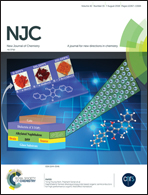Self-assembled cobalt(ii)porphyrin–fulleropyrrolidine triads via axial coordination with photoinduced electron transfer†
Abstract
Self-assembly by donor–acceptor complex formation in the (2,3,7,8,12,18-hexamethyl,13,17-diethyl,5-(2-pyridyl)porphinato)cobalt(II) (CoIIP)–1′-N-methyl-2′-(pyridin-4-yl)pyrrolidino[3′,4′:1,2][60]fullerene (PyC60) system was studied using chemical thermodynamics/kinetics, UV-vis, IR, 1H NMR spectroscopy, amperometry and quantum chemical B3LYP-D3/6-31G(d,p) methods. The results revealed the formation of a supramolecular 1 : 2 triad between CoIIP and PyC60. The equilibrium/rate constants of the donor–acceptor triad formation are observed to be (1.04 ± 0.12) × 1010 L2 mol−2 and (63.7 ± 4.5) mol−1 L s−1, respectively. The numerical values of these equilibrium/rate constants demonstrate a strong bonding between the CoIIP and fulleropyrrolidine moieties. The triad LUMO energy levels are predominantly spread on the C60 unit. However, the HOMO energy levels are mainly spread on the porphyrin ring pointing at the property of photoinduced electron transfer (PET) in the obtained triad. Modification of the covered natural oxide film titanium electrode surface in the voltammetry experiment was carried out by using the porphyrin–fullerene triad and the self-assembly components. The maximum efficiency coefficient of the incident photon energy conversion to current (IPCE) and photocurrent density values of (PyC60)2CoIIP at 365 nm are significantly larger than those of CoIIP and PyC60. The results are of interest for creating porphyrin-based donor–acceptor systems as components in organic photovoltaics.



 Please wait while we load your content...
Please wait while we load your content...